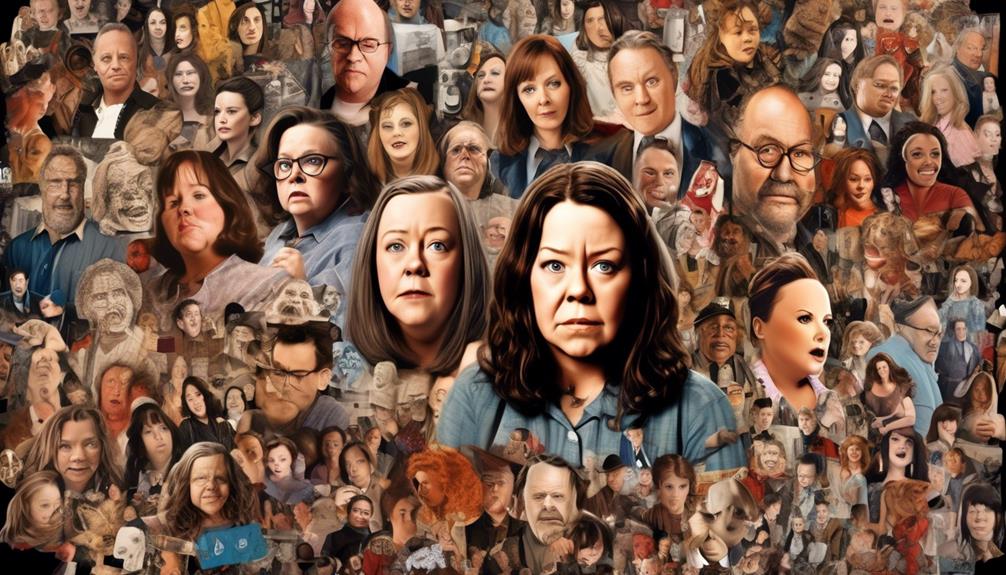In the dimly lit movie theater, the screen comes alive, showcasing characters crafted from a blend of emotions and behaviors. These personas from the world of cinema captivate us with their intricate nature, captivating us with their depiction of Borderline Personality Disorder.
But what lies beneath the surface of these characters, and how do their stories contribute to our understanding of BPD? Join us as we explore the nuances of movie characters grappling with this intricate mental health condition, unraveling the impact of their struggles on both the big screen and real life.
Key Takeaways
- Impulsive behaviors and intense emotions characterize movie characters with BPD.
- Films highlight fear of abandonment, identity struggles, and emotional volatility.
- Portrayal fosters empathy, awareness, and understanding of individuals with BPD.
- Relationship dynamics in movies showcase idealization, devaluation, and emotional rollercoaster patterns.
Portrayal of BPD in Cinema
In cinema, portrayals of Borderline Personality Disorder (BPD) often highlight characters exhibiting impulsive behavior, emotional instability, and a fear of abandonment. Movies about Borderline Personality often delve into the inner struggles faced by individuals with BPD, providing a platform for raising awareness about the complexities of the disorder. These films offer a representation of borderline personality traits through characters entangled in intense relationships, grappling with self-destructive tendencies, and struggling with their sense of self.
The emotional instability portrayed in movies featuring characters with BPD showcases the turbulent nature of their personalities and the challenges they encounter in managing their emotions. Fear of abandonment is a recurring theme in these portrayals, reflecting the deep-seated anxieties that individuals with BPD often experience in relationships. By shedding light on the erratic behavior and intense emotional experiences of characters with BPD, these films contribute to a better understanding of the disorder and its impact on individuals' lives.
Analysis of Movie Characters

Characters in films portraying Borderline Personality Disorder often exhibit a range of behaviors and emotions that reflect the complexities associated with the disorder. In movies such as 'Eternal Sunshine of the Spotless Mind' and 'Silver Linings Playbook,' characters like Clementine and Tiffany display impulsive behaviors and intense emotions, characteristic of individuals with BPD.
Similarly, Anakin Skywalker from 'Star Wars' embodies traits like fear of abandonment and intense passion, resonating with those facing similar challenges. 'Crazy Ex-Girlfriend' and 'Girl, Interrupted' feature characters like Rebecca Bunch and Susanna Kaysen who showcase impulsiveness and self-loathing common among individuals with BPD.
Moreover, characters from Marvel Comics like Harley Quinn and Jessica Jones illustrate fear of abandonment and trauma, shedding light on the struggles faced by those with BPD. BoJack Horseman's portrayal of identity struggles and intense emotions further adds to the nuanced representation of individuals with BPD in cinema.
Impact on Awareness and Understanding
Portraying movie characters with Borderline Personality Disorder serves as a valuable tool in enhancing public awareness and understanding of the complexities associated with the disorder. Films featuring characters with BPD offer a window into the challenges and symptoms that individuals with this condition face daily. These portrayals illustrate the impact of BPD on relationships, shedding light on the struggles individuals may encounter in their interactions with others.
Watching these characters can evoke feelings of empathy and compassion, fostering a deeper understanding of the experiences of those living with BPD. Additionally, the depiction of BPD in movies can play a crucial role in destigmatizing mental health issues, sparking conversations and promoting a more accepting and supportive environment for individuals with BPD. Through these cinematic representations, audiences can gain insight into the nuances of Borderline Personality Disorder, ultimately contributing to a more informed and empathetic society.
Depiction of BPD Symptoms

The cinematic portrayal of Borderline Personality Disorder symptoms often vividly captures the intense emotional reactions and impulsive actions exhibited by characters with BPD traits. These depictions in movies frequently emphasize the fear of abandonment and the struggles with maintaining stable relationships that individuals with BPD may experience. Characters reflecting BPD symptoms often showcase self-destructive tendencies, identity struggles, and black-and-white thinking, which contribute to their complex personalities on screen. Manipulative behavior, emotional volatility, and self-harm are commonly depicted symptoms that add depth to these characters and highlight the challenges they face. The following table provides a summary of the key symptoms of BPD often portrayed in movies:
| Symptoms | Examples in Movies |
|---|---|
| Fear of abandonment | Character constantly seeks reassurance |
| Unstable relationships | Rapidly shifting dynamics with others |
| Emotional volatility | Extreme mood swings |
Relationship Dynamics in Films
Exploring the intricate relationship dynamics depicted in films featuring characters with BPD reveals the profound impact of the disorder on interpersonal connections. These characters often struggle with fear of abandonment, leading to intense and tumultuous relationships marked by emotional volatility. The idealization and devaluation tendencies exhibited in these films add layers of complexity to their interactions, showcasing the challenges faced by individuals with BPD in forming and maintaining stable connections.
The portrayal of romantic relationships in movies featuring BPD characters often emphasizes the rollercoaster nature of their love lives, illustrating the difficulties they encounter in sustaining fulfilling partnerships.
Platonic relationships depicted in these films highlight the struggles individuals with BPD face in forming and maintaining friendships, showcasing the impact of the disorder on various types of interpersonal connections.
The tumultuous connections showcased in films involving BPD characters serve as a window into the complexities of navigating relationships while grappling with the challenges posed by the disorder.
Frequently Asked Questions
What Movie Characters Have Borderline Personality Disorder?
We know that identifying movie characters with Borderline Personality Disorder (BPD) can provide insights into the complexities of this condition. By examining the behaviors and traits exhibited by characters like Lisa Rowe in 'Girl, Interrupted' and Tiffany Maxwell in 'Silver Linings Playbook,' we gain a deeper understanding of how BPD manifests in various narratives.
These portrayals offer valuable perspectives on the challenges individuals with BPD face in navigating their identities and relationships.
What Disney Character Has Borderline Personality Disorder?
When exploring Disney characters for signs of Borderline Personality Disorder, Elsa from Frozen and Raven from Teen Titans come to mind. Their struggles with fear of abandonment and emotional volatility hint at potential BPD traits.
While not definitively diagnosed within the movies, their behaviors align with common BPD characteristics. Analyzing these characters through a mental health lens can offer valuable insights for viewers experiencing similar challenges.
Why Is BPD Life Expectancy 27?
BPD's life expectancy being 27 is due to various factors, including a higher risk of suicide, risky behaviors, substance abuse, and challenges in seeking consistent treatment.
Co-occurring mental health conditions like depression and anxiety further impact longevity.
Early detection, accurate diagnosis, and comprehensive treatment plans are crucial for improving outcomes.
Proper management of BPD symptoms can positively influence life expectancy and overall well-being.
Which Superhero Has Bpd?
When discussing superheroes with Borderline Personality Disorder (BPD), characters like Harley Quinn and Jessica Jones come to mind. Their impulsive actions, fear of abandonment, and intense emotions resonate with BPD traits.
These characters provide a platform to explore the complexities of mental health in a fictional setting, shedding light on the struggles individuals with BPD face.
Their stories offer insight into the challenges of managing intense emotions and forming stable relationships.
Conclusion
In conclusion, the portrayal of characters with Borderline Personality Disorder in movies serves as a lens through which we can better understand the complexities of this condition.
By examining their struggles with relationships, emotions, and self-image, we gain insight into the challenges faced by individuals living with BPD.
These cinematic depictions contribute to raising awareness and promoting empathy towards those grappling with the daily realities of this disorder.
Val brings a wealth of knowledge and empathy to our team, crafting articles that touch the heart and enlighten the mind. As an expert writer, she dives deep into the subjects of BPD, offering informative and deeply relatable perspectives. Val’s contributions are instrumental in making complex psychological concepts accessible to our audience, helping to foster understanding and compassion.










